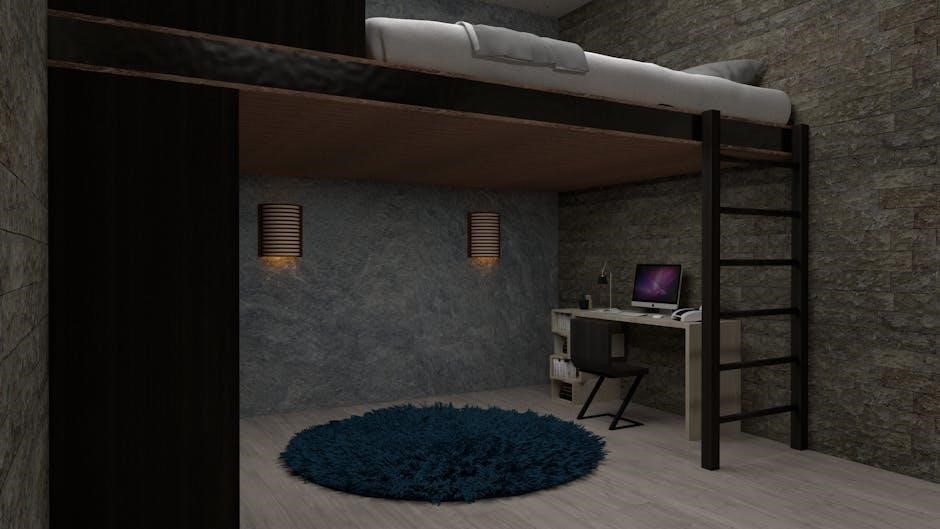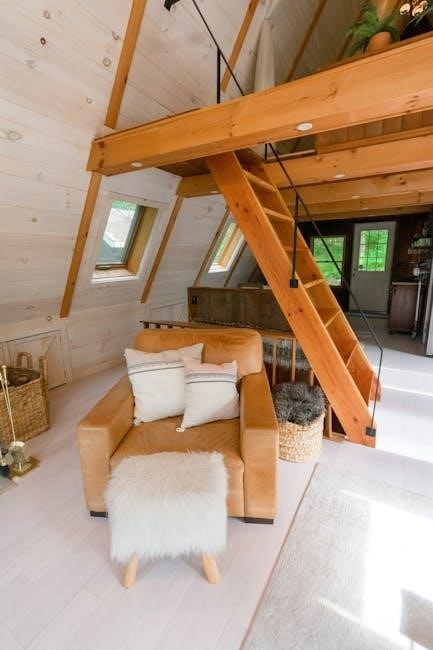Welcome! This guide provides step-by-step instructions for safely assembling your new loft bed. Please read all safety warnings and general notes carefully before beginning. Gather all required tools and verify all parts are present using the parts list. Let’s begin the assembly process to create an awesome space!
Safety Warnings and General Notes
Before you commence the assembly of your loft bed, it is absolutely crucial to carefully review and understand these safety warnings and general notes. Your safety and the structural integrity of the bed depend on adhering to these guidelines. Failure to follow these instructions may result in serious injury or damage to the product.
Weight Limits: Always be aware of the weight limit specified for your loft bed model. Exceeding this limit can compromise the bed’s stability and lead to collapse. Ensure that the mattress and occupants combined do not surpass the maximum weight capacity.
Guardrails: Never use the bed without guardrails properly installed on all open sides of the upper bunk. These guardrails are essential for preventing falls and injuries during sleep.
Wall Attachment: If your loft bed includes a wall attachment feature, it is highly recommended to secure the bed to the wall. This provides additional stability and prevents the bed from tipping over.
Assembly Location: Choose a spacious and well-lit area for assembly. This will allow you to move freely and ensure that you can clearly see all parts and connections.
Children: Keep children away from the assembly area to prevent accidents and injuries.
Read Instructions: Thoroughly read all instructions before starting assembly. This will help you understand the process and avoid mistakes.
Tools Required for Assembly
Before embarking on the loft bed assembly journey, gathering the necessary tools is paramount for a smooth and efficient process. Having the right tools at your disposal not only expedites the assembly but also ensures that each component is securely fastened, contributing to the overall stability and safety of the loft bed.
Essential Tools:
- Screwdrivers: A set of both Phillips head and flathead screwdrivers of varying sizes is essential. These will be used to tighten screws and bolts throughout the assembly process. A magnetic screwdriver can be particularly helpful for holding screws in place, especially in hard-to-reach areas.
- Allen Wrench (Hex Key): Loft beds often utilize Allen bolts, so a set of Allen wrenches (hex keys) is crucial. Ensure you have a variety of sizes to match the different bolts included in the assembly kit.
- Wrench Set: An adjustable wrench or a set of open-end wrenches will be needed to tighten nuts and bolts securely. Having a range of sizes will accommodate different fastener sizes.
- Rubber Mallet: A rubber mallet can be useful for gently tapping components into place without damaging the finish.
- Measuring Tape: A measuring tape will help you ensure that components are aligned correctly and that the bed is positioned properly in your room.
- Level: A level is essential for ensuring that the bed frame is perfectly level, which is crucial for stability and safety.
Parts List and Identification
Before diving into the assembly of your loft bed, it’s crucial to meticulously inventory and identify each component. This step ensures you have all the necessary parts and familiarizes you with their names and functions, preventing potential delays and frustration during the assembly process. Cross-referencing the physical parts with the detailed parts list provided in the instruction manual is highly recommended.
Key Components to Identify:
- Bed Frame Components: These typically include the headboard, footboard, side rails, and support beams. Identify each piece and note any distinguishing features.
- Ladder Components: Locate the ladder rungs, side supports, and any connecting hardware. Ensure you have the correct number of rungs and that the supports are in good condition.
- Guardrails: Identify the guardrail sections, end posts, and connecting hardware. Pay attention to the orientation of each piece to ensure proper installation.
- Mattress Platform Supports: These are the slats or solid surface that will support the mattress. Verify you have the correct number and that they are in good condition.
- Fasteners: Separate and identify all screws, bolts, nuts, washers, and other hardware. Organize them by size and type for easy access during assembly.
Take your time with this step, as accurate identification of parts will significantly streamline the assembly process.
Step 1: Assembling the Bed Frame
The initial stage of loft bed construction involves assembling the main bed frame, a foundational step that dictates the overall stability and structural integrity of the entire unit. Begin by laying out all the necessary components – typically the headboard, footboard, and side rails – on a flat, protected surface. Ensure you have ample space to maneuver and prevent any accidental scratches or damage to the finish.
Carefully align the side rails with the headboard and footboard, paying close attention to the orientation of any pre-drilled holes or connection points. Using the appropriate hardware (bolts, screws, and washers, as specified in the parts list), securely fasten the side rails to the headboard and footboard. Tighten the fasteners gradually, working in a circular pattern to ensure even distribution of pressure and prevent warping or misalignment.

Once the main frame is assembled, double-check all connections to ensure they are snug and secure. Wobbly or loose connections can compromise the stability of the bed and pose a safety hazard. With the frame assembled, you can move on to the next step.
Step 2: Attaching the Ladder
Now we proceed to attaching the ladder, which is crucial for safe access to the loft bed. First, identify the designated location for the ladder attachment on the bed frame, usually on one of the side rails. Refer to the assembly diagram for precise positioning. Align the ladder with the attachment points, ensuring that it sits flush against the frame. Use the provided hardware – typically bolts, screws, or specialized ladder hooks – to secure the ladder to the frame.
If using bolts and screws, insert them through the ladder supports and into the pre-drilled holes on the bed frame, tightening them gradually and evenly. If your ladder utilizes hooks, ensure they are properly engaged and locked onto the frame’s edge. Double-check that the ladder is stable and can bear weight before fully tightening all fasteners.

Once secured, test the ladder by carefully climbing up and down to ensure it feels sturdy and doesn’t wobble. If any instability is detected, re-tighten the connections or adjust the ladder’s positioning. The ladder should be securely attached and provide a safe and comfortable means of accessing the lofted sleeping area.
Step 3: Installing Guardrails
This step focuses on installing the guardrails, a critical safety feature preventing falls from the loft bed. Identify the guardrail components and their designated locations along the open sides of the bed frame. Typically, guardrails attach to the inside of the bed frame, providing a secure barrier along the sleeping area. Align the guardrails with the pre-drilled holes or attachment points on the frame. Using the appropriate hardware, such as bolts, screws, or specialized fasteners, secure the guardrails to the frame.
Ensure that the guardrails are oriented correctly, with the top edge positioned at a safe height above the mattress surface. Tighten all fasteners gradually and evenly to ensure a secure and stable connection. Once installed, carefully inspect the guardrails to confirm they are firmly attached and do not wobble or flex excessively. Apply pressure to different points along the guardrails to test their stability.

If any movement or instability is detected, re-tighten the fasteners or adjust the guardrail’s positioning. It’s crucial to ensure the guardrails are robust and can withstand pressure, providing a safe sleeping environment. Remember to install guardrails on both long sides of the upper bunk for maximum safety.
Step 4: Mattress Platform Installation
Now, let’s install the mattress platform, which provides the necessary support for the mattress. Identify the components of the platform, which may include wooden slats, metal grids, or a solid panel. Carefully lift and position the mattress platform inside the bed frame, ensuring it rests securely on the designated supports. If using wooden slats, space them evenly across the frame, following the manufacturer’s instructions for optimal weight distribution and support.
Secure the slats to the frame using screws or other fasteners, ensuring they are tightly connected and cannot shift during use. If the platform consists of a metal grid or solid panel, align it with the frame and secure it using the provided hardware. Double-check that the platform is level and stable before proceeding.
Test the platform by applying weight to different areas to ensure it can adequately support the mattress and a person sleeping on it. If any instability or sagging is detected, reinforce the platform or adjust the supports as needed. A properly installed mattress platform is essential for comfort, safety, and the longevity of your loft bed.
Step 5: Stabilizer Bar Placement

This step involves the installation of the stabilizer bar, a crucial component for enhancing the overall stability and safety of your loft bed. Identify the stabilizer bar from the parts list – it’s typically a metal bar designed to connect two points of the bed frame, minimizing sway and movement. Determine the designated location for the stabilizer bar, as specified in the instructions. This is often at the back of the bed, connecting the two side frames.
Carefully align the stabilizer bar with the pre-drilled holes or mounting points on the bed frame. Use the provided screws or bolts to securely fasten the stabilizer bar to the frame. Ensure that the connections are tight and that the bar is firmly in place. The hooks of the stabilizer bar should be placed against the wall. This bar helps to ensure that your loft bed remains stable and secure, especially during movement.
Once installed, double-check the stability of the entire structure. Any wobbling indicates a need for adjustment. Ensure the stabilizer bar is correctly positioned and tightly fastened, contributing significantly to the loft bed’s sturdiness.

Step 6: Desk Assembly (if applicable)
If your loft bed includes a desk, this step outlines the assembly process. First, unpack all desk components and refer to the desk-specific parts list. Identify the desktop, legs, support beams, and any drawers or shelves. Begin by attaching the legs to the desktop using the provided screws and hardware. Ensure the legs are aligned correctly and securely fastened for stability.
Next, connect any support beams or frames to the legs, reinforcing the desk’s structure. If drawers are included, assemble them separately according to the instructions, then slide them into the designated slots under the desktop. For shelves, attach them to the desk frame, ensuring they are level and securely mounted. Once the desk is fully assembled, carefully position it beneath the loft bed, aligning it with the designated space.
Ensure the desk is stable and does not interfere with the bed’s structure or ladder access. Adjust the desk’s position as needed to optimize space and functionality. A well-assembled desk provides a practical workspace, enhancing the loft bed’s utility.
Step 7: Shelf Installation (if applicable)
This step is only applicable if your loft bed set includes shelves. Begin by identifying all shelf components: the shelf boards, support brackets, screws, and any necessary hardware. Refer to the parts list to ensure you have everything needed. Start by determining the desired placement of the shelves. Consider factors like accessibility, weight distribution, and overall aesthetics. Mark the locations for the support brackets on the bed frame, ensuring they are level and evenly spaced.
Attach the support brackets to the bed frame using the provided screws. Make sure the brackets are securely fastened to prevent the shelves from wobbling or falling. Once the brackets are in place, carefully position the shelf boards on top of them. Align the shelves properly and secure them to the brackets using additional screws if required.
Double-check that the shelves are stable and can support the intended weight. If necessary, adjust the brackets or add extra support for added stability. Properly installed shelves provide valuable storage space, helping to keep the area tidy and organized.
Step 8: Bookcase Assembly (if applicable)
This step applies only if your loft bed includes a bookcase. First, unpack all the bookcase components: side panels, shelves, back panel, and hardware. Consult the parts list to ensure everything is accounted for. Begin by assembling the bookcase frame. Attach the side panels to the base, using screws or cam locks as specified in the instructions.
Next, insert the shelves into the frame. Some shelves may be adjustable, allowing you to customize the spacing. Secure the shelves using shelf supports or screws, ensuring they are level and stable. Attach the back panel to the bookcase frame. This panel provides structural support and prevents items from falling out the back.
Carefully lift and position the assembled bookcase into its designated space under the loft bed. Ensure it fits snugly and is properly aligned. Secure the bookcase to the loft bed frame using screws or brackets, if necessary. This will prevent the bookcase from tipping over and provide additional stability to the entire structure. Double-check all connections to ensure the bookcase is securely attached and can safely hold books and other items.
Step 9: Securing the Loft Bed to the Wall (if applicable)
This step is crucial for safety, especially if the loft bed will be used by children or in areas prone to movement. Before you begin, identify a suitable wall stud behind the desired location of the loft bed. Use a stud finder to accurately locate the stud.
Position the loft bed against the wall, ensuring it is level and in the desired location. Align the provided wall-mounting brackets with the stud. Mark the screw locations on the wall through the bracket holes. Pre-drill pilot holes at the marked locations. This will make it easier to insert the screws and prevent the wood from splitting.

Attach the wall-mounting brackets to the wall stud using appropriate screws. Ensure the brackets are securely fastened and can support the weight of the loft bed. Connect the brackets to the loft bed frame using the provided hardware. Double-check all connections to ensure they are tight and secure. Test the stability of the loft bed by gently shaking it. If there is any movement, re-tighten the connections or consider using additional wall anchors for added security.
Weight Limit Information
Understanding and adhering to the weight limits of your loft bed is paramount for safety and ensuring the longevity of the product. The maximum weight capacity for this loft bed is explicitly stated on a label affixed to the bed frame and in the accompanying documentation. It is crucial to never exceed this limit.
This weight limit encompasses the combined weight of the mattress and the person or persons occupying the bed. For example, if the weight limit is 250 lbs, the combined weight of the mattress and the user should not exceed this value. Regularly check the mattress weight and ensure that the user is aware of the weight restrictions.
Exceeding the specified weight limit can compromise the structural integrity of the loft bed, potentially leading to damage, instability, or even collapse. This could result in serious injury. It is the responsibility of the owner to communicate and enforce these weight restrictions to all users of the loft bed.
Troubleshooting Common Assembly Issues
Even with careful instructions, you might encounter minor challenges during the loft bed assembly. One common issue is misaligned screw holes. If this occurs, double-check that you’re using the correct hardware and that the components are oriented correctly. Do not force screws; instead, slightly loosen adjacent connections to allow for adjustments.
Another potential problem is difficulty attaching the ladder or guardrails. Ensure that you are aligning the brackets properly and using the appropriate screws. Sometimes, a rubber mallet can gently help to seat components correctly. If parts seem missing, carefully review the parts list again and contact customer support if necessary.

If the bed frame seems wobbly after assembly, double-check that all screws and bolts are tightened securely. Verify that the floor is level; an uneven floor can cause instability. Use shims under the legs to level the bed. For persistent issues, consult the detailed diagrams and instructions again, or seek assistance from a professional.

Maintenance and Care Tips
To ensure the longevity and safety of your loft bed, regular maintenance is essential. Periodically inspect all screws, bolts, and connections to ensure they remain tight. Loose hardware can compromise the bed’s stability and pose a safety hazard. Tighten any loose connections immediately using the appropriate tools.
Clean the bed frame regularly with a soft, damp cloth. Avoid using harsh chemicals or abrasive cleaners, as these can damage the finish. For wooden frames, consider using a furniture polish to maintain the wood’s luster and protect it from scratches.
Regularly check the ladder and guardrails for any signs of wear or damage. Replace any damaged parts promptly to prevent accidents. Ensure the mattress is properly supported and meets the specified weight limit. Encourage users to avoid jumping or excessive movement on the bed, as this can stress the frame.
Finally, keep the area around the loft bed clear of clutter to minimize the risk of falls. Following these simple maintenance and care tips will help you enjoy your loft bed safely for years to come.
Warranty Information

Your new loft bed is covered by a manufacturer’s warranty against defects in materials and workmanship. The warranty period extends for [insert warranty duration, e.g., one year] from the date of purchase. This warranty applies only to the original purchaser and is non-transferable.
During the warranty period, we will, at our option, repair or replace any defective parts free of charge. This warranty does not cover damage resulting from misuse, abuse, negligence, accidents, alterations, or improper assembly. Normal wear and tear are also excluded.
To make a warranty claim, please contact our customer service department with your proof of purchase and a detailed description of the defect. We may require you to return the defective part for inspection. Shipping costs for warranty claims are the responsibility of the purchaser.
This warranty gives you specific legal rights, and you may also have other rights that vary from state to state. Please retain this warranty information and your proof of purchase for your records. We are committed to providing you with a high-quality product and excellent customer service.
Contact Information for Support
We understand that assembling furniture can sometimes present challenges. If you encounter any difficulties during the assembly process or have questions about your loft bed, our dedicated support team is here to assist you. Please do not hesitate to reach out to us for help.
You can contact us through several convenient channels. Our customer service representatives are available by phone at [insert phone number] during our business hours, which are [insert business hours, e.g;, Monday through Friday, 9 AM to 5 PM EST]. You can also email us at [insert email address], and we will respond to your inquiry as quickly as possible.
For frequently asked questions and troubleshooting tips, please visit the support section of our website at [insert website address]. There, you may find answers to common assembly issues and helpful videos demonstrating specific steps;
When contacting us, please have your order number and the model number of your loft bed readily available. This will help us expedite the support process and provide you with the most accurate information. We are committed to ensuring your satisfaction with our product.










